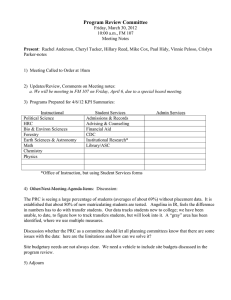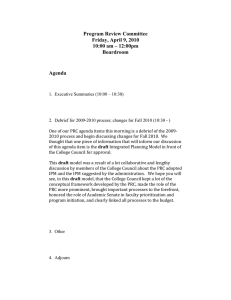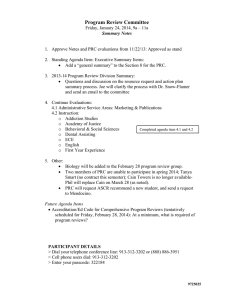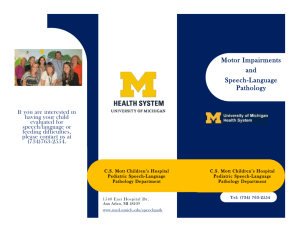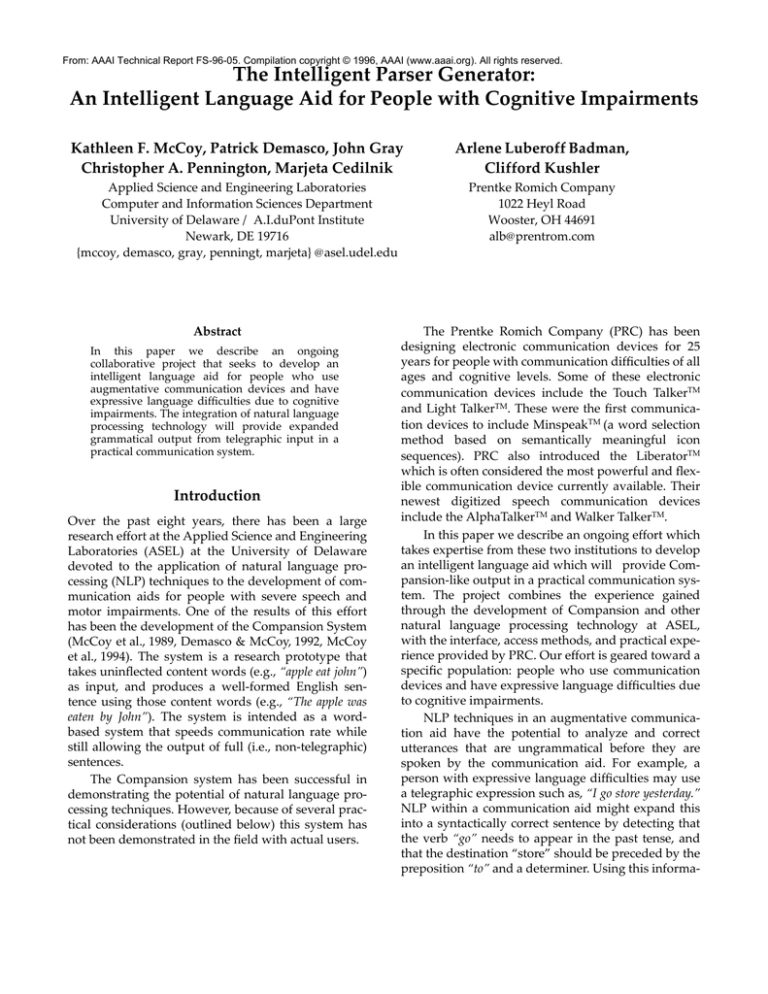
From: AAAI Technical Report FS-96-05. Compilation copyright © 1996, AAAI (www.aaai.org). All rights reserved.
The Intelligent Parser Generator:
An Intelligent Language Aid for People with Cognitive Impairments
Kathleen F. McCoy, Patrick Demasco, John Gray
Christopher A. Pennington, Marjeta Cedilnik
Arlene Luberoff Badman,
Clifford Kushler
Applied Science and Engineering Laboratories
Computer and Information Sciences Department
University of Delaware / A.I.duPont Institute
Newark, DE 19716
{mccoy, demasco, gray, penningt, marjeta} @asel.udel.edu
Prentke Romich Company
1022 Heyl Road
Wooster, OH 44691
alb@prentrom.com
Abstract
In this paper we describe an ongoing
collaborative project that seeks to develop an
intelligent language aid for people who use
augmentative communication devices and have
expressive language difficulties due to cognitive
impairments. The integration of natural language
processing technology will provide expanded
grammatical output from telegraphic input in a
practical communication system.
Introduction
Over the past eight years, there has been a large
research effort at the Applied Science and Engineering
Laboratories (ASEL) at the University of Delaware
devoted to the application of natural language processing (NLP) techniques to the development of communication aids for people with severe speech and
motor impairments. One of the results of this effort
has been the development of the Compansion System
(McCoy et al., 1989, Demasco & McCoy, 1992, McCoy
et al., 1994). The system is a research prototype that
takes uninflected content words (e.g., “apple eat john”)
as input, and produces a well-formed English sentence using those content words (e.g., “The apple was
eaten by John”). The system is intended as a wordbased system that speeds communication rate while
still allowing the output of full (i.e., non-telegraphic)
sentences.
The Compansion system has been successful in
demonstrating the potential of natural language processing techniques. However, because of several practical considerations (outlined below) this system has
not been demonstrated in the field with actual users.
The Prentke Romich Company (PRC) has been
designing electronic communication devices for 25
years for people with communication difficulties of all
ages and cognitive levels. Some of these electronic
communication devices include the Touch TalkerTM
and Light TalkerTM. These were the first communication devices to include MinspeakTM (a word selection
method based on semantically meaningful icon
sequences). PRC also introduced the LiberatorTM
which is often considered the most powerful and flexible communication device currently available. Their
newest digitized speech communication devices
include the AlphaTalkerTM and Walker TalkerTM.
In this paper we describe an ongoing effort which
takes expertise from these two institutions to develop
an intelligent language aid which will provide Compansion-like output in a practical communication system. The project combines the experience gained
through the development of Compansion and other
natural language processing technology at ASEL,
with the interface, access methods, and practical experience provided by PRC. Our effort is geared toward a
specific population: people who use communication
devices and have expressive language difficulties due
to cognitive impairments.
NLP techniques in an augmentative communication aid have the potential to analyze and correct
utterances that are ungrammatical before they are
spoken by the communication aid. For example, a
person with expressive language difficulties may use
a telegraphic expression such as, “I go store yesterday.”
NLP within a communication aid might expand this
into a syntactically correct sentence by detecting that
the verb “go” needs to appear in the past tense, and
that the destination “store” should be preceded by the
preposition “to” and a determiner. Using this informa-
tion, the communication aid might suggest to the user
that the sentence “I went to the store yesterday” be spoken as output. If this is acceptable to the user, it will be
output. If it is not, other possibilities might be suggested. It is expected that a device such as described
here may not only help the user generate understandable English sentences, but might also provide the
user with feedback which may be beneficial in overcoming their expressive difficulties.
In this paper we briefly examine the population
under study along with some of the PRC innovations
currently used by this population. We will then outline the Compansion system and the limitations it
faces in terms of its real-world use. We motivate the
system we envision, and argue why it is a viable
application of natural language processing techniques
in a real world system. Finally, we describe our current efforts.
Target Population
Intact sensory, perceptual, cognitive, and physical
skills are critical for the development of effective communication (Kumin, 1994; Gersh, 1991). Difficulties in
one or a combination of these areas can adversely
affect speech and language development. Perceptual
skills involve giving meaning to any sensory input.
Cognitive skills are needed to develop thinking capacities necessary for understanding, organizing, and
making sense of the world. Cognitive skills include
the ability to attend, remember, problem solve, think
critically, think abstractly, store and retrieve information, and generalize (Gioia, 1993). These skills directly
affect the development of communication skills. Children also need adequate physical skills for speech and
language to develop properly.
Many people using augmentative and alternative
communication (AAC), for one reason or another,
have sensory, perceptual, cognitive, and/or physical
difficulties which affect their communication skills,
particularly their expression of language. For example, children born with cerebral palsy may have physical, visual, auditory, and cognitive difficulties
affecting their speech and language development. The
severity of a deficit or the number of these deficits
often have a correlation with the severity of the communication problem.
Deficits in any of these cognitive areas can
adversely affect the development of both receptive
and expressive language. Whether a child with cognitive impairments is verbal or nonverbal, some general
characteristics of expressive language difficulties may
include (Kumin, 1994; Roth & Casset-James, 1989): (1)
short telegraphic utterances; (2) sentences consisting
of concrete vocabulary (particularly nouns); (3) morphological and syntactical difficulties such as inappropriate use of verb tenses, plurals, and pronouns;
(4) word additions, omissions, or substitutions; and
(5) incorrect word order.
People with cognitive impairments exhibiting
expressive language difficulties such as those listed
above may be functional in expressing their needs
and wants. That is, they may have a limited vocabulary and three- to five-word telegraphic utterances
that they use repeatedly but appropriately to the situation. However, such expressive language often
results in one or more of the following: (1) poor perceptions of the individual as socially and communicatively less competent (Hoag et al., 1994). Hoag, et al.
found that message length was an important variable
to an individual’s perceived communicative competence; (2) a barrier to opportunity, experiences and
interactions (Kumin, 1994; Locke & Mirenda, 1988);
(3) inability to communicate effectively with unfamiliar partners (Locke & Mirenda, 1988); (4) limited experiences resulting in little “world knowledge”
(Koppenhaver et al., 1992); (5) fewer opportunities to
practice language (Blackstone, 1990); (6) poor literacy
development (Koppenhaver et al., 1992; Wilson &
Risucci, 1988); and (7) behavioral problems because of
the lack of ability to communicate and to be understood (Blackstone, 1990).
Our goal is to develop an intelligent communication aid that will overcome the difficulties listed above
and therefore lessen the negative impact of the language deficit. In addition, the system we envision
may have some therapeutic effect since it will be providing positive exemplars of language output based
on the user’s selections.
PRC Expertise with Target Population
The speech output communication aids that PRC
designs for commercial use incorporate an encoding
technique called semantic compaction, commercially
known as MinspeakTM (a contraction of the phrase
“minimum effort speech”). The purpose behind MinspeakTM is to reduce the cognitive demands as well as
the number of physical activations required to generate effective flexible communication. Its success stems
from the use of a relatively small set of pictures called
icons that are rich in meaning and associations. These
icons can be combined to represent a vocabulary item
such as a word, phrase, and sentence, so that only two
or three activations are needed to retrieve an item.
This small set of icons will permit a large vocabulary
to be stored in the device. When the icons have only
one meaning, problems arise from a lack of space on
the device’s display for adequate vocabulary. Since
they are rich in meaning, icons designed for MinspeakTM can be combined in a large number of distinct
sequences to represent a core lexicon easily.
MinspeakTM was first utilized with PRC’s Touch
TalkerTM and Light TalkerTM communication aids.
With such MinspeakTM systems, icons on the overlay
remain in fixed positions, which, once learned, allow
the individual using the system to find them quickly
and automatically. With the design of prestored
vocabulary programs known as MinspeakTM Application Programs (MAPsTM), a large vocabulary could be
stored in a well-organized fashion using a logical, paradigmatic structure that greatly facilitates learning. It
was the combination of the semantic compaction
encoding approach and MAPTM software programs
that permitted the achievement of automaticity,
resulting in high success rates of effective communication.
PRC has developed eight MAPsTM, each designed
for one or more specific client populations. Since MinspeakTM can be used across all cognitive levels and
ages, MAPsTM have been developed for a variety of
populations including young children with severe
and profound multiple handicaps, adolescents with
moderate or mild cognitive impairments, and children and adults with intact cognitive skills. “Communic-EaseTM” (CE) is such a MAPTM, and has been
selected for use in the proposed project. CommunicEaseTM contains basic vocabulary appropriate for a
user chronologically 10 or more years of age with a
language age of 5-6 years. The MAPTM has proven to
be an effective interface for users in our target population.
The Compansion Project
Natural Language Processing is the sub-field of Artificial Intelligence devoted to capturing the regularities
and developing computational mechanism to process
natural languages (such as English). Typically the
field has been broken into 3 areas: syntax (concerned
with the ordering of words and phrases to make legal
sentences), semantics (concerned with the way the
meanings of individual words can be combined to
form a meaningful whole), and pragmatics (concerned with the way the current context affects the
meaning of a sentence). While there has been some
use of natural language processing techniques in augmentative communication, prior to the Compansion
project its use has been fairly limited. For instance,
some syntactic knowledge has been used in the context of word prediction and language tutoring (Swiffin et al., 1987; Vandyke et al., 1992, McCoy &
Suri, 1992; Newell et al., 1992; Wright et al., 1992)).
Several systems at the University of Dundee such as
PROSE (Waller et al., 1992), CHAT (Alm et al., 1987),
and TALKSBACK (Waller et al., 1990, Waller
et al., 1992), use semantic (and pragmatic) knowledge
to allow the user to access context-appropriate chunks
of meaningful language with minimal effort. None of
these systems have used the range of techniques
found in the Compansion system.
The Compansion system uses techniques from
several areas of natural language processing in order
to take a telegraphic message and transform it into a
well-formed English sentence. The Compansion system is broken into several components. First, the word
order parser takes the string of words input to the system and, using syntactic techniques, identifies the
part of speech of each input word (e.g., noun, verb,
adjective), identifies certain modification relationships (e.g., which noun is being modified by an adjective), and passes clausal-sized chunks (such as found
in a sentential complement) to the remainder of the
system.
The second major component of the system is the
semantic parser. This is perhaps the most sophisticated
component of the system. The semantic parser takes
individual content words (e.g., nouns and a single
verb) identified in the previous component as a
clausal-sized chunk, and attempts to fit them together
as a meaningful sentence.The major reasoning of the
semantic parser is driven by semantic (case frame)
information associated with verbs in conjunction with
a knowledge base classifying words according to their
semantic type.
For example, the case frame for the verb “eat”
indicates that it prefers an animate actor and a fooditem theme. Using this information and assuming an
input of “apple eat John”, the semantic parser can correctly infer that “John” is a person doing the eating
and that “apple” is the food being eaten. Once this is
determined, the remaining components of the system
(using further semantic and syntactic processing) are
able to generate a well-formed English sentence
which captures the meaning identified.
The primary goal of the Compansion system prototype was to demonstrate the feasibility of a Natural
Language Processing-based approach to AAC techniques (i.e., is it even possible). While results so far
have been encouraging, additional steps are necessary
to establish its viability in an actual product for a specific user population. For example, one of the major
problems we have is that Compansion requires a large
amount of information associated with each word.
While we have been working on technologies to provide this information automatically, it is currently
nearly impossible to deal well with totally unrestricted vocabulary. Thus the system will work best
with a user population whose vocabulary needs can
be fairly well identified.
A second problem that has not been dealt with
effectively within the Compansion project is the particular interface through which the user interacts with
the system. While the research prototype system has a
particular word-based interface associated with it,
research efforts have dealt with the front-end component as a separate “black box” which provides the system with words. We have not tackled the many issues
involved with developing a front-end appropriate for
a specific population of users. Notice that because the
processing required by the user is fairly complex (i.e.,
s/he must not only select words but must also
accept/reject the expanded sentence produced by the
system), the interface requirements are quite complex.
Experience with the specific population using the
device is required to develop an appropriate interface.
Finally, the research effort on the Compansion
system to date has been done on workstations in the
Lisp language. Thus the system would not run on
portable micro-computers which would be appropriate for use in real-world situations.
System
LCD Display
The proposed project attempts to integrate PRC’s
expertise in AAC product development and support
with ASEL’s research expertise in applying NLP techniques to AAC. PRC has had success with systems
and MAPsTM designed specifically for the target population. In this project, we plan to alter one of these
MAPsTM (the Communic-Ease MAPTM) to make it
appropriate for integration with semantic parsing
(while the users of the system will still have the ability
to spell out words not included on the MAPTM, we
expect that we can anticipate much of the spelled
vocabulary). The existing MAPTM will provide the
base vocabulary and icon sequences used in the envisioned system. ASEL’s Compansion system will provide the theoretical basis for the necessary NLP
techniques. Much of the proposed work will involve
the integration of the parser/generator with existing
PRC hardware and software, the refinement of the
knowledge base (lexicon and grammar) for the target
population, and the development of an appropriate
user interface.
Envisioned System
The envisioned system will combine the Prentke
Romich LiberatorTM system, a modified CommunicEase MAPTM (MinspeakTM Application Program) and
an intelligent parser/generator. A simplified block
diagram of the system is shown below in Figure 1.
The Liberator Overlay/Keyboard accepts user
input via a variety of methods (e.g., direct selection),
and also limits user choices via Icon Prediction. With
1) Feedback of selected Icons & Words
2) Transformed Sentences
Icon Selections
Liberator
Overlay
Keyboard
Prototype Development
Communic-Ease
Minspeak
Application
Program
Input Words
Intelligent Parser/
Generator
Icon Predictions
1) Output Phrases
2) Word & Category Predictions
FIGURE 1. Block Diagram of Envisioned System (speech and print output is not shown). User interacts
with the keyboard/overlay and LCD display. Components unique to this effort are shown in bold.
Icon Prediction only icons that are part of a valid
sequence are selectable. The user selects icon
sequences which are transduced into words or commands according to the Communic-ease MAPTM. In
normal operation, icon labels and the transduced
words are sent to the Liberator LCD display to give
the user feedback (words may also be spoken).
In the envisioned system, these components are
supplemented with an intelligent parser/generator
that is currently under development at ASEL. The
parser/generator is responsible for generating wellformed sentences from the user’s selected words. It is
also responsible for providing further constraints on
the Icon Prediction process. For example, if the user
selected “I have red,” the system might only allow icon
sequences for words that can be described by a color
(e.g., shoe, face).
As previously mentioned, the major role of the
parser/generator is to transform telegraphic input
into well-formed sentences. For example, the input
.
“John go store yesterday” will be transformed into “John
went to the store yesterday.” In some cases there may be
multiple interpretations of a given input. For example, “John go store Tuesday” can be interpreted as “John
went to the store on Tuesday” or “John will go to the store
on Tuesday.” In these cases the system will order the
sentences based on a number of heuristics. For example, in the previous example, the system might prefer
the past tense if previous sentences were in the past
tense.
Transformation rules. The envisioned intelligent
parser/generator will be capable of performing a
variety of linguistic transformations (most of which
are supported by the current ASEL prototype). These
transformation rules are summarized in Table 1. For
each rule in the table, an example input and transformation is shown. These examples (except for the conjunction rule) were obtained from transcripts of a
Transformation Rule
Example input
Example Output
determiner inferencing
I want cookie please mom
I want a cookie please mom.
verb inflection
(subject verb agreement)
She work in school
She works in a school.
verb inflection
(tense addition)
I go my old school Tuesday
I went to my old school on Tuesday.
multiple verbs
I go circus see clowns
I am going to go to the circus to see the
clowns.
noun inflection
Cook 50 dinner
Cook 50 dinners.
preposition inferencing
I dance five girls
I danced with five girls.
verb inferencing
Mr. Keylor industrial arts teacher.
Mr. Keylor is the industrial arts teacher.
subject inferencing
No time
I have no time.
conjunctions
Mom Dad be home.
Mom and Dad are home.
possessives
I see neighbor house
I saw a neighbor’s house.
tense defaulting (tense,
once set, will stay the
same until changed)
1) Dad birthday party on tomorrow Sunday
1) Dad’s birthday party will be tomorrow, Sunday.
2) Grandma papa and Pat sing
happy birthday
2) Grandma, Papa and Pat will sing
Happy Birthday.
3) Dad open present
3) Dad will open presents.
4) We eat cake and ice cream
4) We will eat cake and ice cream.
I football watch Friday 10pm
I am going to watch football on Friday
at 10pm.
word order modification
TABLE 1. Transformation rules for the intelligent parser/generator with example input and human
translations taken from recorded transcripts of a Communic-EaseTM user
Communic-EaseTM user where a family member or
teacher was interpreting the input and transforming it
into a well-formed sentence.
One major advantage of describing transformations as a set of rules is that it is relatively easy to
parametrize the system to affect its overall strategy.
For example, a clinician or teacher could disable any
of the transformation rules depending on the particular user’s abilities or educational goals. For some rules
it will also be possible to specify information about
how the rule should be applied. For example, preferences for determiner inferencing could be adjusted
(e.g., prefer “the” over “a/an”).
Interface Issues. Beyond the basic operation
described above, there are a number of interface
issues that need to be resolved before a completed
product is developed. These issues are being explored
in early system prototypes with iterative user testing.
The first issue of concern is how the intended
population can best interact with the system when
multiple sentences are generated from an input. As
mentioned above, the parser/generator can order output sentences according to a variety of rules. However, it will be important to determine the best way to:
(1) present multiple options to the user; and (2) allow
the user to select from a list of possible choices. A
number of possibilities exist including providing a list
on the LCD screen, offering each sentence one at a
time with some user activated key to ask for the next
choice, and entering into a clarification dialog with
the user (e.g., “Did you mean John already went to the
store?”). All of these options will be explored during
prototype development.
A second major interface issue revolves around
incremental versus non-incremental processing. In
incremental processing, the system would attempt to
transform input on a word-by-word basis. For exam-
ple, if the user selected the word “cat”, the system
might expand it to “The cat.” In contrast non-incremental processing would wait for the entire sentence
to be entered and then produce an output sentence(s).
For example, the input “cat hungry” would be transformed into “The cat is hungry” or “Is the cat hungry?”
depending on the final terminating character (i.e.,
period or question mark). Because of the cognitive
load involved in incremental processing, our initial
prototype is being developed for non-incremental
processing.
Development Methodology
The system described in the previous section is being
developed via a collaborative effort between PRC and
ASEL. The proposed prototype combines the PRC’s
Liberator platform and Communic-Ease MAPTM with
ASEL’s current generation intelligent parser/generator. In the implementation the Liberator will function
primarily as the user’s keyboard and a tablet-based
portable computer will contain the parser/generator.
The portable computer will also replace the Liberator’s LCD display and provide easy modification of
the user interface. The two systems will be connected
via an RS-232 link and physically connected as shown
in Figure 2.
The intelligent parser/generator includes three
major software components. The parser/generator
module is written in C++ (though it is still under
development). In addition two knowledge bases will
be customized for this project. The system dictionary
will include all words contained within the Communic-Ease MAPTM along with a variety of words that
users may spell out. This knowledge base contains
semantic knowledge such as noun categories and
properties as well as morphological properties such as
Tablet-based
portable computer
PRC Liberator
FIGURE 2. Phase I prototype will combine a PRC Liberator with a tablet-based portable computer
connected with an RS-232 line. This strategy allows for rapid initial prototype development.
word endings. Syntactic knowledge is captured in the
system grammars which are based on an Augmented
Transition Network (ATN) formalism.
Our methodology in this project is to develop and
test the robustness and usability of the system in
phases. Currently we are in the process of developing
a robust parser written in C++. At the same time we
are collecting transcripts of users using the Communic-Ease MAPTM. In some cases, in addition to the
actual keystrokes produced by the system user, we
have collected and transcribed video tapes of the user
(and have asked a communication partner to, whenever appropriate, speak the expanded sentence they
believe the user to be selecting).
This data provides the project with a range of
input and output sequences necessary for our system
to handle. We are currently in the process of developing the grammar and necessary knowledge bases to
handle the transcribed sessions. At the same time, we
are working out the details of the interface so that the
system can be field tested with actual users.
Acknowledgments
This work has been supported by an SBIR grant
(National Institutes of Health, US Department of
Health and Human Services #1 R41 DC 02338-01A1),
and by a Rehabilitation Engineering Research Center
Grant from the National Institute on Disability and
Rehabilitation Research of the U.S. Department of
Education #H133E30010 to the University of Delaware. Additional support has been provided by the
Nemours Research Program.
References
Alm, N., Newell, A., & Arnott, J. (1987). A communication aid which models conversational patterns. In
R. Steele & W. Gerrey (Eds.), Proceedings of the
Tenth Annual Conference on Rehabilitation Technology (pp. 127–129). Washington, DC: RESNA.
Blackstone, S. W. (1990). Augmentative Communication
News, 3, 3–4.
Demasco, P. W. & McCoy, K. F. (1992). Generating text
from compressed input: An intelligent interface
for people with severe motor impairments. Communications of the ACM, 35(5), 68–78.
Gersh, E. S. (1991). What is cerebral palsy? In E. Geralis
(Ed.), Children with cerebral palsy: A parent’s guide
(pp. 1–32). Rockville, MD: Woodbine House.
Gioia, G. A. (1993). Development and mental retardation. In R. Smith (Ed.), Children with mental retardation: A parent’s guide (pp. 51–88). Rockville, MD:
Woodbine House.
Hoag, L. A., Bedrosian, J. L., Johnson, D. E., & Molineux, B. (1994). Variables affecting perceptions
of social aspects of the communicative competence of an adult AAC user. Augmentative and Alternative Communication, 10, 129–137.
Koppenhaver, D. A., Coleman, P. L., & Steelman, J. D.
(1992). Literacy issues in augmentative and alternative communication. Two week seminar,
Chapel Hill.
Kumin, L. (1994). Communication skills in children with
Down Syndrome: A guide for parents. Rockville,
MD: Woodbine House.
Locke, P. A. & Mirenda, P. (1988). A computer-supported communication approach for a child with
severe communication, visual, and cognitive impairments: A case study. Augmentative and Alternative Communication, 4, 15–22.
McCoy, K. F., Demasco, P., Gong, Y., Pennington, C.,
& Rowe, C. (1989). Toward a communication device which generates sentences. In J. J. Presperin
(Ed.), Proceedings of the Twelfth Annual RESNA
Conference (pp. 41–43). Washington, D.C.: RESNA
Press.
McCoy, K. F., Demasco, P. W., Jones, M. A., Pennington, C. A., Vanderheyden, P. B., & Zickus, W. M.
(1994). A communication tool for people with disabilities: Lexical semantics for filling in the pieces. In Proceedings of the First Annual ACM
Conference on Assistive Technologies (pp. 107–114).
New York: ACM.
McCoy, K. F. & Suri, L. Z. (1992). Designing a computer tool for deaf writers acquiring written English.
Presented at ISAAC-92. Abstract appears in Augmentative and Alternative Communication, 8.
Newell, A. F., Arnott, J. L., Beattie, W., & Brophy, B.
(1992). Effect of “PAL” word prediction system
on the quality and quantity of text generation.
Augmentative and Alternative Communication, (pp.
304–311).
Roth, F. P. & Casset-James, E. L. (1989). The language
assessment process: Clinical implications for individuals with severe speech impairments. Augmentative and Alternative Communication, 5, 165–
172.
Swiffin, A. L., Arnott, J. L., & Newell, A. F. (1987). The
use of syntax in a predictive communication aid
for the physically impaired. In R. Steele & W. Gerrey (Eds.), Proceedings of the Tenth Annual Conference on Rehabilitation Technology (pp. 124–126).
Washington, DC: RESNA.
Vandyke, J., McCoy, K., & Demasco, P. (1992). Using
syntactic knowledge for word prediction. Presented at ISAAC-92. Abstract appears in Augmentative and Alternative Communication, 8.
Waller, A., Alm, N., & Newell, A. (1990). Aided communication using semantically linked text modules. In J. J. Presperin (Ed.), Proceedings of the 13th
Annual RESNA Conference (pp. 177–178). Washington, D.C.: RESNA.
Waller, A., Broumley, L., & Newell, A. (1992). Incorporating conversational narratives in an AAC device. Presented at ISAAC-92. Abstract appears in
Augmentative and Alternative Communication,
8.
Wilson, B. C. & Risucci, D. A. (1988). The early identification of developmental language disorders
and the prediction of the acquisition of reading
skills. In R. L. Masland & M. W. Masland (Eds.),
Preschool prevention of reading failure (pp. 187–203).
Parkton, MD: York Press.
Wright, A., Beattie, W., Booth, L., Ricketts, W., & Arnott, J. (1992). An integrated predictive word processing and spelling correction system. In J.
Presperin (Ed.), Proceedings of the 15th Annual RESNA Conference (pp. 369–370). Washington, DC:
RESNA.



